It takes just 15 minutes to drive from Portogruaro to Cordovado, a municipality in Friuli Venezia Giulia where you can still see the remains of the old medieval town and its mighty walls.
The town was given to the bishop of Concordia Sagittaria in order to defend a branch of the Tagliamento river that has now dried up. The name “Cordovado” comes from the Latin words “Curtis” and “Vadum”, which refer to a court near a ford across the Tagliamento river.
The little town has been officially listed among the most beautiful villages in Italy by the “Borghi Più Belli d’Italia” association. Still today, you can admire its old walls, complete with ramparts, a moat and two entrance towers, one of which has a drawbridge. When you visit this little town, you’ll soon find yourself picturing atmospheric historical scenes, with rich lords and ladies, merchants, soldiers and artisans.
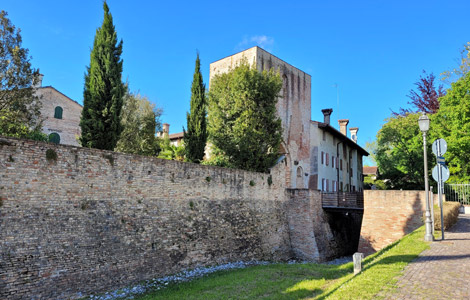
The bishop of the diocese of Concordia Sagittaria was the predominant force in Cordovado in the early days, but in 1420 AD it came under the control of the Republic of Venice and lost its defensive, military and ecclesiastical role.
The first Shrine to the Virgin Mary in the Diocese was built here in 1592 after a Marian apparition and it became a famous destination for numerous pilgrims. It’s a Baroque gem that can still be seen today.
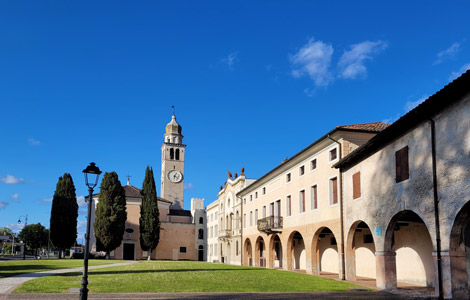
What to see in Cordovado
The historic centre of the town in the Province of Pordenone is the most interesting part to visit. History is intertwined with the fragrances and colours of the countryside and the peaceful horizons of writer Ippolito Nievo’s fields.
You can enter the Medieval Castle through one of the two gate towers that are still standing, one of which has a drawbridge you can cross. It’s also fascinating to walk around the outside of the walls, admiring the moat and the south-west ramparts. It’s a great way to take stunning photos of a truly picturesque place.
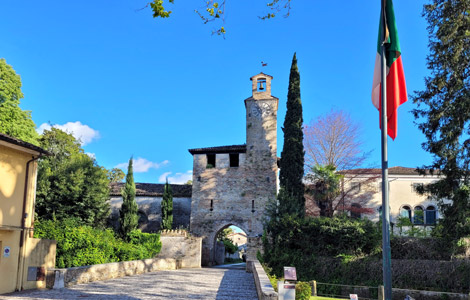
Once you’ve gone through the entrance, you’ll find a large courtyard with a number of buildings looking over it:
- The Church of San Girolamo – standing right next to the northern gate of the fortified town.
- Palazzo Freschi/Piccolomini – built in the late 17th century by the noble Attimis family, its façade and floor plan both reflect the classic style of Venetian architecture. As well as a number of age-old trees, its walled grounds contain Damask rose bushes arranged to form a sun-shaped maze.
- Palazzo Bozza/Marrubini – used for staff housing and as a service building, this refined construction dates back to the 15th century. It features porticoes, arches and a host of frescoes.
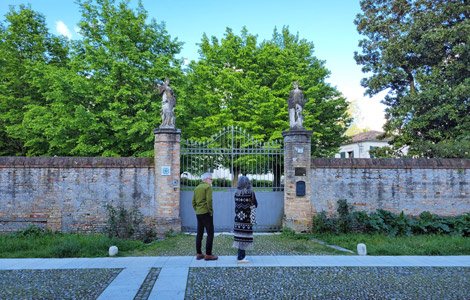
- Palazzo Agricola – the large arches at the front of this Renaissance building provide access to the ground floor. Its grounds and garden stretch out behind it. You can stop for a refreshing break at the café on the ground floor.
- Outside the medieval castle, just past the drawbridge of the southern tower, you’ll find the Romano-Gothic style Church of Sant’Andrea, which was opened in 1966. It contains various pieces of contemporary art by the Veronese artist Pino Casarini, including paintings, glass and works of plastic art.
- At the entrance to the North Tower is a First World War memorial to remember those who fell during the conflict and serve as a warning to young people today.
- A short walk of a few hundred metres will take you to the complex containing the Town Hall. Nearby stands the Sanctuary of the Madonna delle Grazie, which was built in 1603 after an appearance of the Virgin Mary. The building is adorned with stucco work, bas-reliefs, statues, paintings and frescoes.
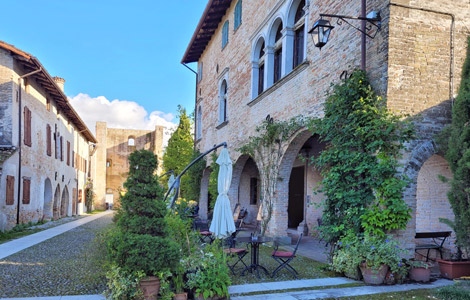
The Ippolito Nievo literary park
A literary park is a place that can inspire the works of numerous authors, thanks to features shaped by humans and nature that encapsulate the historical, natural and cultural values of local communities.
The concept for the Ippolito Nievo literary park was devised by the writer Stanislao Nievo in conjunction with Cordovado Town Council and the Ippolito Nievo Foundation, because the poet’s works were inspired by this area, and especially the Old Cathedral, the square outside the Sanctuary of the Madonna delle Grazie, the nearby Fontana di Venchiaredo and the Stalis Watermills.
Visiting holy sites in Cordovado
Cordovado’s historic and artistic heritage is enriched by a number of churches. The ones that you can visit in the town’s historic centre are as follows:
- The Church of Sant’Andrea (also known as the Old Cathedral) has been destroyed and rebuilt a number of times. Inside, octagonal pillars hold up large arches and trusses support the wooden roof. The 16th century frescoes in the main chapel are attributed to Gianfrancesco da Tolmezzo. The bell tower stands on the northern side.
- The octagonal Sanctuary of the Madonna delle Grazie was opened on 1 May 1603. Following the appearance of the Virgin Mary, numerous pilgrims travelled to it. The building is adorned with stucco work, bas-reliefs, statues, paintings and frescoes. Giovanni Grassi made the high altar out of marble.
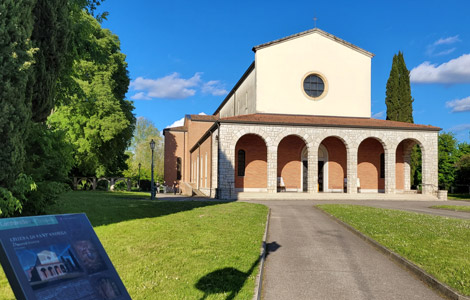
- The oratory of Santa Caterina has frescoes on its southern and northern walls that are attributed to pupils of Tommaso da Modena from Veneto and Friuli, as well as other local artists. There’s an interesting altarpiece with a Madonna and Child.
- Standing right next to the northern gate of the old town, the church of San Girolamo in Castello is now private property. It has a single nave, with visible brickwork. There are barrel tiles on the sloping roof, which is supported by trusses. There’s a marble altar in the apse, with an 18th century altarpiece. On one wall is a fresco showing the Virgin Mary on a throne, between a female saint and Saint James the Great.
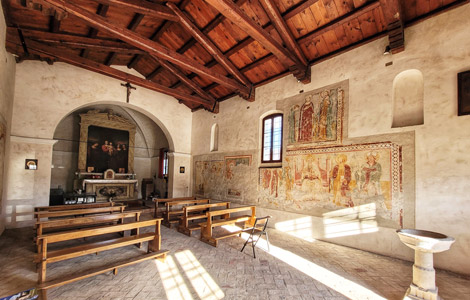
Historical re-enactments and the Palio dei Rioni
If you’re on holiday in the area in the last week of August or the first week of September, we highly recommend a trip to Cordovado to see the stunning historical re-enactments and the Palio dei Rioni.
300 people in historical costumes go through the town on a breathtaking parade from the medieval castle to the large archery range. There, teams from the different districts in the town battle it out in tests of speed, strength and skill that are all part of the Palio dei Rioni.
Watching the evocative displays is like travelling back through time and experiencing life in the olden days: there are flag-wavers, medieval dinners and games, painted ladies, dancing, music and drums playing a feverish beat, not to mention specially decorated inns and osterias serving a rustic soup called “Zuppa del Bifolco” and other delights. For information, contact the Pro Cordovado Association: procordovado@gmail.com
How to get to Cordovado
Cordovado is just 10 kilometres from Portogruaro and it takes about 15 minutes to drive there. Take the SP463 provincial road and go through the little village of Cintello along Via Garibaldi.
You can also travel from Portogruaro to Cordovado by taxi or bus, but bear in mind that there are only a couple of buses a day.
If you decide to cycle to Cordovado from Portogruaro, we recommend going via Portovecchio, Boldara and Gruaro, because it’s a quieter road so it’s better for bike rides. In addition, the scenery is beautiful and you’ll go past a number of interesting sites, such as the Boldara Watermills, the Stalis Watermills and the Fontana di Venchiaredo. It should take you about 45 minutes.
Guided tours of Cordovado
When you’re visiting a city, town or village, it’s always a good idea to find an expert guide who can provide you with invaluable information and help you to appreciate its art, history and people. At Cordovado tourist information centre (tel. +39 434 684099) you can book a range of guided tours, from a “Complete historical tour” lasting approximately two hours to slightly shorter tours lasting an hour or an hour and a half. You can book tours here https://turismocordovado.it/visite-guidate/ Cordovado is a little town that’s full of charm, history, tales and traditions dating back to the Middle Ages and beyond. We recommend paying it a visit during your next holiday in one of our resorts.
Cordovado is only a short drive from Bibione, Caorle and Jesolo. If you haven’t booked yet, now’s the ideal time. Head to our website,where the information about availability for all accommodation is kept up to date at all times.
